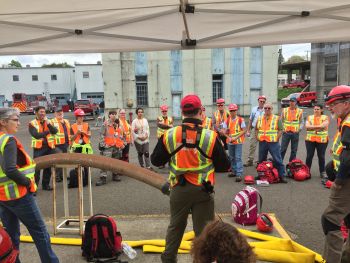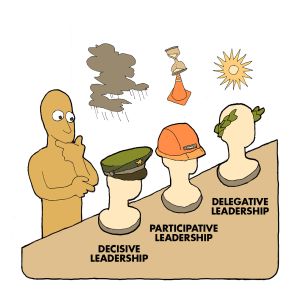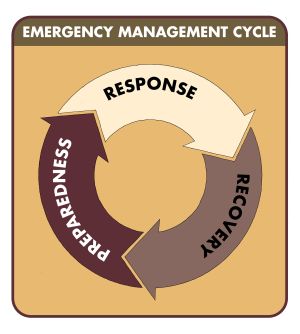Chapter 1: Introduction to Being a NET Team Leader

FEMA's Community Emergency Response Team (CERT) curriculum includes a well-written resource, CERT Tools for Leadership Success,[1] that presents leadership best practices for disaster response volunteer teams. So why does Portland NET need our own volunteer Leadership Workbook?
Though Portland NET uses the CERT curriculum, NET has grown increasingly more complex than a typical CERT program. Portland's program manages more volunteers and logs more volunteer hours than most CERT programs. We also collaborate more often with neighbors, community institutions, and other stakeholders. While this NET Team Leader Workbook borrows from existing resources, it also addresses the expanded leadership skills needed to manage a Portland Neighborhood Emergency Team.
Chapter 1 learning objectives
- Understand the three types of volunteer leadership styles recognized for CERT by FEMA and PBEM.
- Feel confident connecting a specific leadership style to a specific NET activity.
- Recognize the relationship between the Disaster Management Cycle and community resilience.
- Connect the concepts of community resilience to the work Portland NET does.
Blue Skies Leadership vs. Incident Command

CERT Tools for Leadership Success suggests varying leadership styles depending on the situation:
- Decisive leadership for urgent situations (for example, NETs responding in the aftermath of a natural disaster);
- Participative leadership for controlled situations (for example, NET volunteers deployed to the scene of a down power line, or at a planned deployment such as the Grand Floral Parade);
- Delegative leadership for planned situations (for example, a team meeting where NETs conduct response planning in partnership with the community).
This Workbook focuses on delegative leadership during "blue skies" periods.[2] This includes activities such as:
- Team management and goal setting;
- Response planning and preparations;
- Training and exercise;
- Community relationship building.
The PBEM volunteer leader positions this workbook most apply to are NET Team Leaders, Assistant Team Leaders, and BEECN Coordinators.
A separate NET publication concerning NET Operations and the job of NET Incident Commander (NET IC) will explore the style of leadership required in controlled (participative leadership) and urgent (decisive leadership) situations.
What is a PBEM Volunteer Team Leader?

In order to dive into the varied roles of a NET Team Leader, we must first consider what a NET Team Leader leads, exactly. What is a Neighborhood Emergency Team, and why does PBEM organize NET volunteers into teams?
As mentioned earlier, while NET has roots in CERT, CERT and NET are not exactly the same thing. That distinction becomes relevant as we define "NET Team Leader". According to FEMA, the CERT mission encompasses:
- Reducing hazards in homes, workplaces, and neighborhoods.
- Responding to the immediate needs of families and communities brought about by disaster.
- Responding as a team to do the greatest good for the greatest number of people.
If we defined NET the same way, NET would be invested almost entirely in disaster response. However, response is only one part of Portland NET's mission; we also consider the other phases of the disaster management cycle including Preparedness and Recovery. Furthermore, we approach the disaster management cycle from the perspective of community resilience. To PBEM, community resilience means a shared, community-based practice building social connections, collective strengths, and skills key to resisting/absorbing/recovering from a widespread disaster, as well as local and regional emergencies.
NET trained and certified volunteers make the backbone of a Neighborhood Emergency Team, but the community resilience mission provides opportunities to involve others from the community: ATVs, businesses, faith-based institutions, schools, and more. In fact, PBEM encourages NETs to open meetings to anyone in the neighborhood with an interest in community resilience.
'Restore connection' is not just for devices, it is for people too.— Arianna Huffington
Furthermore, the severity of the impact of a disaster often discriminates along social lines: income, ethnicity, ability, and linguistic isolation. Social inequality factors can, and often do, determine outcomes when assessing how well a community resists, absorbs, or recovers from a disaster. Strengthening a community's social fabric through the practice of community resilience can improve those outcomes for everybody.
For example, the church down the street would probably like to know about their local NET, prepare their congregation, and offer more prospective volunteers. The principal at the nearby elementary school and the local fire captain may have suggestions for a NET operations plan, and may ask to be included in it. The owner of the mini-mart a few blocks away may have resources that could be of use in the aftermath of a disaster. Community resilience means engaging the community, understanding their disaster preparedness needs, and identifying ways they can help prepare for a disaster, respond in the aftermath, or participate in the recovery.
What is bad for the beehive cannot be good for the bee.— Marcus Aurelius
In order to foster community resilience, NET Team Leaders should set up and maintain a group process; manage varied stakeholders; plan strategically, develop goals and track results; conduct outreach and community engagement; improve equity and inclusion; and resolve conflicts. Philosophers debate whether leaders are born or made. But even if leaders are born, a born leader would still need to learn how to run a neighborhood emergency team. This Workbook exists to facilitate that learning.
Team Leader Role Fundamentals
At the most basic level, the role of Team Leader serves these purposes in their Team and for the community:
- Community leader: You are part of a community of neighbors invested in preparedness and resilience; as Team Leader, you are the glue that holds that community together.
- Keeps the team ready for deployment: The Team Leader is ultimately responsible for the readiness of their team members to deploy in response to a catastrophic disaster.
- Preserves an effective chain of command: PBEM does not have the span of control necessary to interface with every individual volunteer. The Team Leader effectively serves as the "representative" of the other volunteers to PBEM. The Team Leader communicates with PBEM staff about their team's needs, questions, and concerns.
If that's the "What" of PBEM volunteer leadership, the "How" is what this training program is all about.
Anecdotal example: Different leadership for different seasons
| Sidebar: Catch and Release | |
Many large CERT programs elsewhere practice “catch and release” – they train volunteers, but do not organize them. How or why is NET different? Two reasons. First: though NET is an all-hazards response program, we want to feel ready to respond after a Cascadia Subduction Zone earthquake. A disaster of that magnitude will result in a disaster zone covering many hundreds of miles, with government resources tied up for weeks. Given little (or no) expected government assistance, communities must plan together now.
| |

Before Europeans arrived in America, Cherokee Nation government traditionally recognized two governments in each town, with two chiefs: a “White Government” leading during times of peace, and a “Red Government” during times of war. A White Chief, with his advisors, had charge over the ceremonial life of the village, advised on farming, settled disputes, and other domestic issues. The Red Chief maintained a war council to command in battle, scouting, preparation, and war rituals.
Similarly, in the Roman Republic, Senators managed the day-to-day government of the Republic and led in times of war. But if the Republic fell into crisis, the Senators appointed a dictator, with almost total executive power, to serve until the crisis passed or was resolved.
The Romans and Cherokee acknowledged needing different leadership for different situations. This should also imply a leader may perform well in one type of leadership role but perhaps poorly in another. In CERT, the same leader who leads effectively in a disaster response may not prove the most effective leader when more group process is called for. We encourage volunteers to evaluate the skills of their leaders, and expectations of them, carefully. NET allows that a team may assign the responsibilities of a NET Team Leader and NET IC to different individuals.